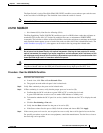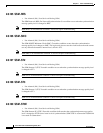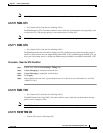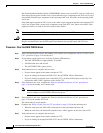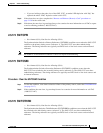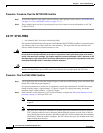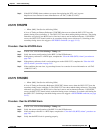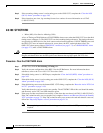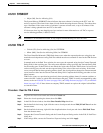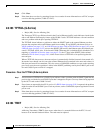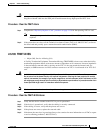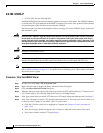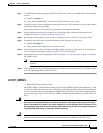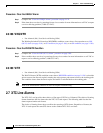
2-117
Cisco ONS 15327 Troubleshooting Guide, R3.4
March 2004
Chapter 2 Alarm Troubleshooting
Alarm Procedures
Step 3 If the SYNC-FREQ alarm continues to report after replacing the XTC card, log onto
http://www.cisco.com/tac for more information or call TAC (1-800-553-2447).
2.6.178 SYNCPRI
• Minor (MN), Non-Service Affecting (NSA)
A Loss of Timing on Primary Reference (SYNCPRI) alarm occurs when the ONS 15327 loses the
primary timing source (reference 1). The ONS 15327 uses three ranking timing references. The timing
references are typically two BITS-level or line-level sources and an internal reference. If SYNCPRI
occurs, the ONS 15327 should switch to its secondary timing source (reference 2). Switching to the
secondary timing source also triggers a SWTOSEC condition (see page 2-115).
Procedure: Clear the SYNCPRI Alarm
Step 1 In node view, click the Provisioning > Timing tabs.
Step 2 Verify the current configuration for the REF-1 of the NE Reference.
Step 3 If the primary reference is a BITS input, complete the “Clear the LOS (BITS) Alarm” procedure on
page 2-82.
Step 4 If the primary reference clock is an incoming port on the ONS 15327, complete the “Clear the LOS
(OC-N) Alarm” procedure on page 2-85.
Step 5 If the condition does not clear, log onto http://www.cisco.com/tac for more information or call TAC
(1-800-553-2447).
2.6.179 SYNCSEC
• Minor (MN), Non-Service Affecting (NSA)
A Loss of Timing on Secondary Reference (SYNCSEC) alarm occurs when the ONS 15327 loses the
secondary timing source (reference 2). The ONS 15327 uses three ranked timing references. The timing
references are typically two BITS-level or line-level sources and an internal reference. If SYNCSEC
occurs, the ONS 15327 should switch to the third timing source (reference 3) to obtain valid timing for
the ONS 15327. Switching to the third timing source also triggers a SWTOTHIRD condition (see page
2-115).
Procedure: Clear the SYNCSEC Alarm
Step 1 In node view, click the Provisioning > Timing tabs.
Step 2 Verify the current configuration of the REF-2 for the NE Reference.
Step 3 If the secondary reference is a BITS input, complete the “Clear the LOS (BITS) Alarm” procedure on
page 2-82.
Step 4 Verify that the BITS clock is operating properly.



